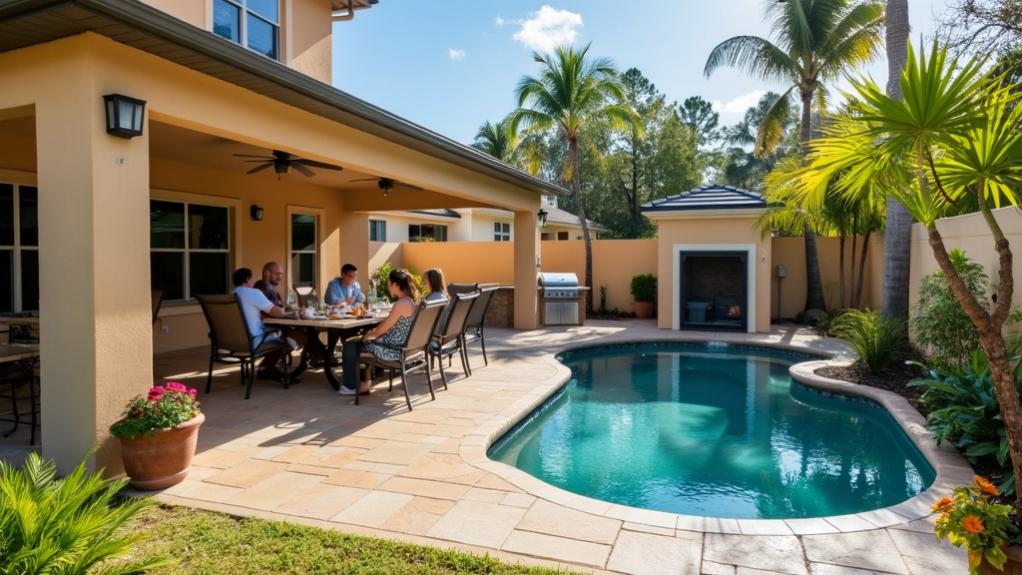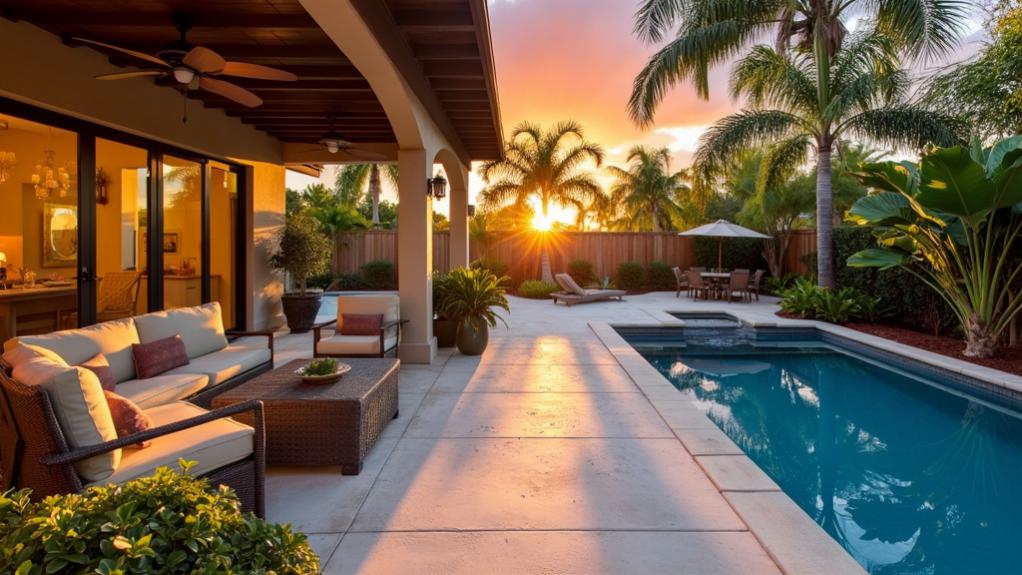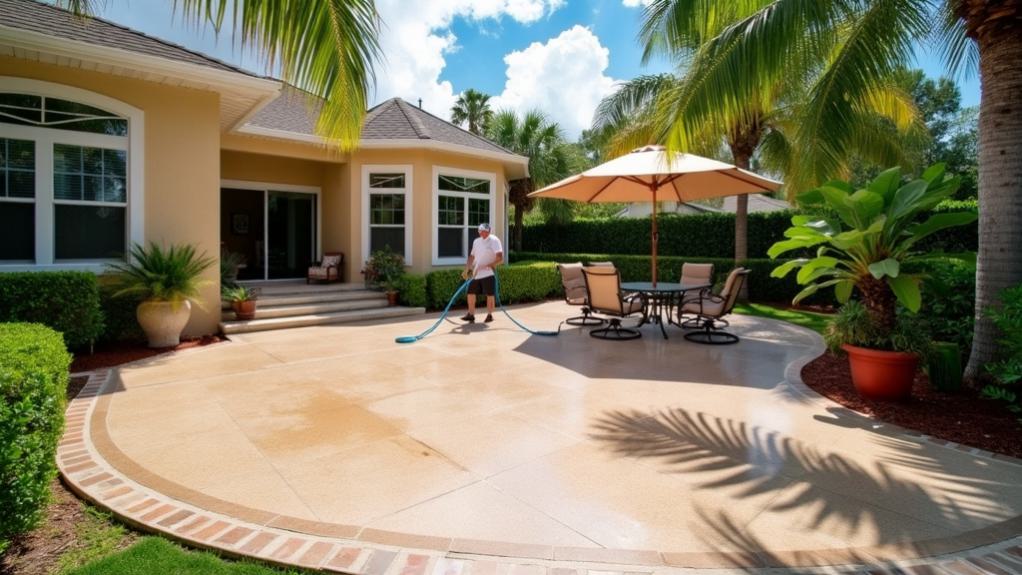Concrete patios offer Florida homeowners a durable and versatile solution for outdoor living spaces. These low-maintenance surfaces withstand harsh sun, heavy rain, and high humidity while providing cost-effective, long-lasting appeal. Design options range from simple slabs to intricate stamped patterns mimicking natural materials. Florida-specific considerations include climate-adapted mixes, hurricane preparedness, and salt exposure mitigation for coastal areas. The installation process involves careful site preparation, reinforcement, and precision pouring. Regular maintenance, including cleaning and sealing, ensures longevity. By addressing unique regional challenges and offering customizable aesthetics, concrete patios emerge as an ideal choice for creating stylish, resilient outdoor environments in the Sunshine State.
Benefits of Concrete Patios

Homeowners in Florida seeking to enhance their outdoor living spaces can benefit significantly from concrete patios. These versatile structures offer a multitude of advantages, combining durability with aesthetic appeal.
Concrete patios withstand Florida's harsh climate, resisting damage from intense sunlight, heavy rainfall, and high humidity. Their low-maintenance nature ensures longevity, reducing the need for frequent repairs or replacements.
Cost-effectiveness is a key benefit of concrete patios. The initial investment is often lower compared to other materials, and the long-term savings on maintenance further enhance their economic value. Additionally, concrete's thermal properties help regulate outdoor temperatures, potentially reducing cooling costs for adjacent indoor spaces.
From an environmental perspective, concrete patios offer several advantages. They can be constructed using locally sourced materials, reducing transportation-related emissions.
Modern concrete mixtures often incorporate recycled materials, minimizing waste and conserving natural resources. The reflective properties of lighter-colored concrete can mitigate the urban heat island effect, contributing to a more sustainable outdoor environment.
Concrete's versatility in design allows for customization to suit various architectural styles and personal preferences, making it an ideal choice for creating functional and attractive outdoor living spaces in Florida.
Design Options and Patterns
When considering concrete patios in Florida, the array of design options and patterns available is vast and varied. Homeowners can choose from a multitude of styles, ranging from simple, monolithic slabs to intricate, decorative surfaces that mimic natural stone or tile.
Stamped concrete offers the ability to replicate the look of brick, slate, or cobblestone, while exposed aggregate finishes provide a unique, textured appearance.
Color choices play a crucial role in concrete patio design. Integral coloring agents can be mixed into the concrete before pouring, ensuring consistent hues throughout the slab. Alternatively, surface-applied stains and dyes allow for custom color patterns and artistic effects.
Texture variations further enhance the visual appeal and functionality of concrete patios. Smooth finishes offer a sleek, modern look, while broom-finished or salt-finished surfaces provide increased slip resistance, ideal for pool decks and outdoor kitchens.
For a more luxurious feel, polished concrete can create a glossy, reflective surface. Scoring and sawcutting techniques enable the creation of geometric patterns or simulated tile layouts, adding visual interest and breaking up large expanses of concrete.
Florida-Specific Considerations

The Sunshine State's unique climate and environmental conditions necessitate special considerations when installing concrete patios. Florida's high humidity, frequent rainfall, and intense sun exposure require concrete mixes with enhanced weather resistance. Contractors often incorporate additives to improve durability and reduce moisture absorption, ensuring longevity in the face of these challenging elements.
Local regulations play a crucial role in patio design and construction. Many Florida municipalities have specific requirements for outdoor living spaces, including setback distances, permeable surface ratios, and stormwater management. Homeowners and contractors must navigate these regulations to ensure compliance and avoid potential fines or reconstruction.
The prevalence of hurricanes and tropical storms in Florida demands additional structural considerations. Concrete patios should be reinforced and properly anchored to withstand high winds and potential flooding. Designers often incorporate features like built-in drainage systems and slightly elevated surfaces to mitigate water accumulation during heavy rains.
Salt exposure in coastal areas can accelerate concrete deterioration. Specialized sealants and corrosion-resistant reinforcements are essential to combat this issue, prolonging the patio's lifespan and maintaining its aesthetic appeal in salty environments.
Installation Process
With Florida's unique considerations addressed, attention turns to the intricate process of installing concrete patios.
The installation begins with meticulous site preparation, a crucial step that ensures the longevity and stability of the patio. This involves excavating the area to the appropriate depth, typically 4-6 inches, and compacting the soil to create a solid foundation. A layer of gravel is then added and leveled to promote proper drainage.
Next, forms are constructed using wood or flexible materials to define the patio's shape and edges. Reinforcement, such as wire mesh or rebar, is placed within the forms to enhance the concrete's structural integrity. Before pouring concrete, it's essential to establish the correct slope for water runoff, typically 1/4 inch per foot away from the house.
The concrete pouring process requires precision timing and coordination. The mix is carefully poured into the forms, then screeded and floated to achieve a smooth, even surface. Expansion joints are cut at strategic intervals to prevent cracking.
Maintenance and Longevity

Maintaining concrete patios in Florida's unique climate is essential for ensuring their longevity and preserving their aesthetic appeal. Regular cleaning using appropriate techniques is crucial to prevent the accumulation of dirt, mold, and mildew, which thrive in the state's humid environment.
Pressure washing, combined with specialized concrete cleaners, effectively removes stubborn stains and organic growth without damaging the surface.
Sealing options play a vital role in protecting concrete patios from Florida's harsh elements. Penetrating sealers offer protection against moisture infiltration and salt damage, while topical sealers provide a protective layer that enhances the patio's appearance and resistance to UV rays.
Reapplication of sealers should be performed every 2-3 years, depending on exposure and wear.
To maximize longevity, homeowners should address cracks promptly, using epoxy or polyurethane fillers for small fissures and professional repair for larger issues.
Regular inspections can identify potential problems early, preventing costly repairs.
Conclusion
Concrete patios offer Florida homeowners a durable, versatile solution for expanding outdoor living spaces. With a myriad of design options, from stamped patterns to textured finishes, these installations can be tailored to complement any architectural style. When properly installed and maintained, concrete patios withstand Florida's harsh climate, resisting UV damage, humidity, and occasional freezing temperatures. Regular sealing and prompt repair of cracks ensure longevity. By considering local regulations, drainage requirements, and sun exposure, homeowners can create functional, aesthetically pleasing outdoor areas that enhance property value and lifestyle.
